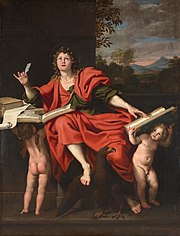Johannine community
| Part of a series of articles on |
| John in the Bible |
|---|
 |
| Johannine literature |
| Authorship |
| Related literature |
| See also |
The term Johannine community refers to a hypothetical ancient Christian community, which placed great emphasis on the teachings of Jesus and of his apostle John; they supposedly authored the Gospel of John, the Johannine Epistles and the Book of Revelation.
Their version of Christian belief and practice may be referred to as Johannine Christianity. Writers who have developed and promoted the community's hypothetical existence include Raymond E. Brown[1] and Harold W. Attridge.[2]
Hypothesis[]
This section contains too many or overly lengthy quotations for an encyclopedic entry. (January 2021) |
According to Attridge, this community of early followers of Jesus "defined themselves rather starkly against the Jewish milieu in which they arose, these believers cultivated an intense devotion to Jesus as the definitive revelation of God's salvific will. They understood themselves to be in intimate contact with him and with one another, under the guidance of the Spirit-Paraclete. They were conscious of their relationship to other believers with whom they hoped to be in eventual union. Their piety found distinctive expression in a reflective literary corpus that explored new ways of expressing faith in Jesus."[3]
"Their common life included ritual actions known to other followers of Jesus, but they insisted on the unique spiritual value of those rites. Disputes eventually divided the community. By the middle of the second century some representatives of the Johannine tradition achieved a respected role in the emerging 'Great Church', the interconnected web of believers throughout the Mediterranean that provided mutual support and maintained fellowship under the leadership of emerging episcopal authorities. The Johannine community of the first century bequeathed to the universal church its distinctive literary corpus and estimation of Jesus,[4] which came to dominate the development of later Christian orthodoxy. Other representatives of Johannine Christianity, nurturing alternative strands of tradition, influenced various second-century movements, characterized by their opponents and much modern scholarship as 'Gnostic'."[3]
Debate[]
For much of the 20th century, scholars interpreted the Gospel of John within the paradigm of this hypothetical Johannine community,[5] meaning that the gospel sprang from a late-1st-century Christian community excommunicated from the Jewish synagogue (probably meaning the Jewish community)[6] on account of its belief in Jesus as the promised Jewish messiah.[7] This interpretation, which saw the community as essentially sectarian and standing outside the mainstream of early Christianity, has been increasingly challenged in the first decades of the 21st century,[8] and there is currently considerable debate over the social, religious and historical context of the gospel.[9] Scholars including Adele Reinhartz and Robert Kysar have challenged the idea of a Johannine community, and cite the lack of evidence for such a community.[10] Nevertheless, scholars such as Attridge have maintained that the Johannine literature as a whole (made up of the gospel, the three Johannine epistles, and Revelation), points to a community holding itself distinct from the Jewish culture from which it arose while cultivating an intense devotion to Jesus as the definitive revelation of a God with whom they were in close contact through the Paraclete.[2]
In 2007, a first attack on the notion of a Johannine community was brought on by Anglican biblical scholar Richard Bauckham in his book Jesus and the Eyewitnesses: here, Bauckham argued that the Gospel of John was actually written by John the Presbyter, who was, in his view, the Beloved Disciple. He also considers him to be the author of the Johannine Epistles, while the Book of Revelation was, according to Bauckham, written by another writer, John of Patmos.[11]
More recently, the existence of a Johannine Community has been challenged by Hugo Mendez (University of North Carolina at Chapel Hill): in an article on the Journal for the Study of the New Testament, Mendez argued that there was never a Johannine community and that the Gospel of John and the Johannine Epistles have all been written by a single author.[12] Mendez thesis received a detailed critique by Johannine scholar Paul N. Anderson (George Fox University) on The Bible and Interpretation,[13] to which Mendez responded with another article on the same publication.[14]
See also[]
References[]
- ^ Brown, Raymond Edward (1979). The Community of the Beloved Disciple. Paulist Press. ISBN 978-0-8091-2174-8.
- ^ Jump up to: a b Attridge 2006, p. 125.
- ^ Jump up to: a b Mitchell, Margaret M.; Young, Frances M.; Bowie, K. Scott. Cambridge History of Christianity: Volume 1, Origins to Constantine. Cambridge University Press. pp. 125–143. ISBN 978-0-521-81239-9.
- ^ "Johannine Community". www.bibleodyssey.org. Retrieved 2020-12-02.
- ^ Lamb 2014, p. 2.
- ^ Hurtado 2005, p. 70.
- ^ Köstenberger 2006, p. 72.
- ^ Lamb 2014, p. 2-3.
- ^ Bynum 2012, p. 7,12.
- ^ Mendez, Hugo (2020). "Did the Johannine Community Exist?". Journal for the Study of the New Testament. 42 (3): 350–74. doi:10.1177/0142064X19890490.
- ^ Richard, Bauckham (2017). Jesus and the Eyewitnesses, 2d ed. Wm. B. Eerdmans Publishing. ISBN 978-0-8028-7431-3.
- ^ Méndez, Hugo (2020-03-01). "Did the Johannine Community Exist?". Journal for the Study of the New Testament. 42 (3): 350–374.
- ^ "On Biblical Forgeries and Imagined Communities—A Critical Analysis of Recent Criticism | Bible Interp". The Bible and Interpretation. Retrieved 2021-07-19.
- ^ "The Elusive Contexts of the Johannine Literature | Bible Interp". bibleinterp.arizona.edu. Retrieved 2021-07-19.
Bibliography[]
- Bellinzoni, Arthur J. (25 February 2000). The Early Christian Community: From Diversity to Unity to Orthodoxy. Lecture delivered to the Wells College Faculty Club.
- Johannine literature
- 2nd-century Christianity